Speech US Monetary Policy and Australian Financial Conditions
Introduction
Thank you for the opportunity to speak at this Bloomberg event today. I'd like to address some issues about how monetary policy decisions taken elsewhere influence interest rates here in Australia.
Australia is a small open economy that is influenced by developments in the rest of the world. Financial conditions here can be affected by changes in monetary policy settings elsewhere, most particularly in the United States given its importance for global capital markets. However, Australia retains a substantial degree of monetary policy autonomy by virtue of its floating exchange rate. In other words, a change in policy rates elsewhere need not mechanically feed through to Australian interest rates. While Australian banks raise significant amounts of funding in offshore markets, they are able to insulate themselves – and by extension Australian borrowers – from changes in interest rates in other jurisdictions.
Just before delving into the details, some context is in order. First, Australian banks have long borrowed in wholesale markets, including those offshore. However, they do so much less than used to be the case (Graph 1).[1] For a number of reasons, domestically sourced deposits have become an increasingly large share of overall funding for banks.[2]
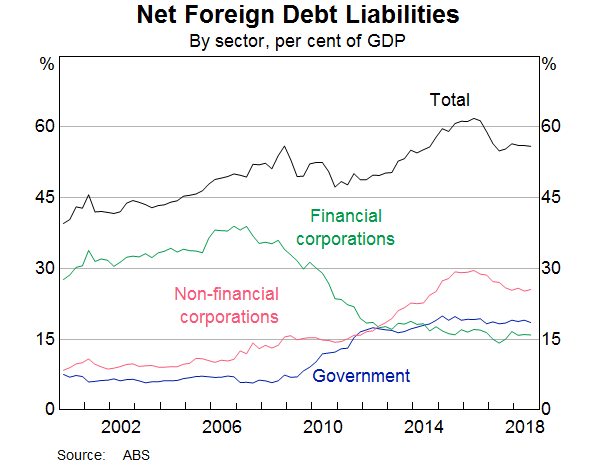
Second, to the extent that Australian banks have continued to tap offshore wholesale markets, it is worth reflecting on some of the characteristics of this borrowing. For instance, some banking sectors around the world borrow in US dollars in order to fund their portfolios of US dollar assets.[3] This can leave them vulnerable to intermittent spikes in US interest rates. However, this is generally not the case for Australian banks. Rather, a good deal of the borrowing by Australian banks in US dollars reflects the choice of the banks to diversify their funding base in what are deep, liquid capital markets. By implication, if the costs in the offshore US dollar funding market increased noticeably relative to the home market, then Australian banks can pursue other options. They might opt to issue a little less in the US market for a time, switching to other markets or even issuing less offshore. They are not ‘forced’ to acquire US dollars at any price, as some other banks may be. Another important feature of this offshore funding, as I will address in detail in a moment, is that the banks are not exposed to exchange rate risks as they hedge their borrowings denominated in foreign currencies.
Independence – It's an Australian Dollar Thing
As you are well aware, the US Federal Reserve has been raising its policy rate in recent years, and interest rates in the United States are now higher than in Australia. These developments reflect differences in spare capacity and inflation: unemployment in the United States is at very low levels, inflation is at the Fed's target and inflationary pressures appear to be building. Since August 2016 – the last time the Reserve Bank changed its cash rate target – the Federal Reserve has raised its policy rate seven times, by 175 basis points in total (Graph 2). Yet while Australian banks raise around 15 per cent of their funding in US dollars, interest rates paid by Australian borrowers since then have been little changed.
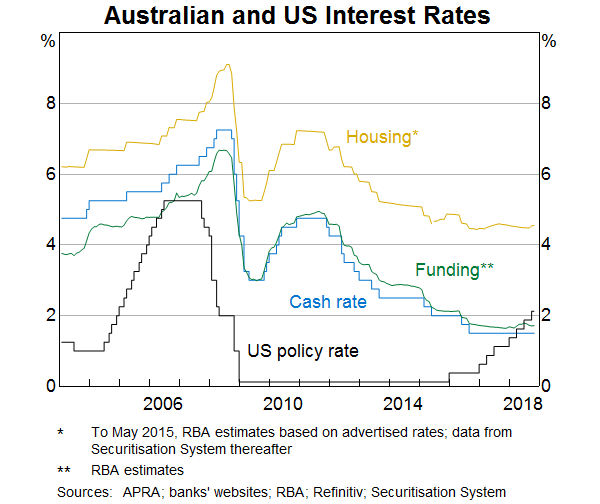
How is it that interest rates for Australian borrowers have been so stable, despite Australian banks having borrowed some US$500 billion in the US capital markets, in US dollars, paying US dollar interest rates? The answer lies in the hedging practices of the Australian financial sector. As I'll demonstrate, Australian banks use hedging markets to convert their US interest rate obligations into Australian ones.
The Australian banks fund their Australian dollar assets via a number of different sources. Some of their funds are obtained in US dollars from US wholesale markets. In order to extend these USD funds to Australian residents, they convert the US dollars they have borrowed into Australian dollars soon after the securities are issued in the US. On the surface it would appear that such transactions could give rise to substantial foreign exchange and interest rate risks for Australian banks given that:
- the banks must repay the principal amount of the security at maturity in US dollars. So an appreciation of the US dollar increases the cost of repaying the loan in Australian dollar terms; and
- the banks must meet their periodic coupon (interest) payments in US dollars, which are tied to US interest rates (either immediately if the security has a floating interest rate, or when the security matures and is re-financed). So a rise in US interest rates (or an appreciation of the US dollar) would increase interest costs for Australian banks that extend loans to Australian borrowers.
However, it is standard practice for Australian banks to eliminate, or at least substantially reduce, these risks. They can do this using a derivative instrument known as a cross-currency basis swap. Such instruments are – when used appropriately – a relatively cost effective way of transferring risks to parties with the appetite and capacity to bear them.
Simply put, cross-currency basis swaps allow parties to ‘swap’ interest rate streams in one currency for another. They consist of three components (Figure 1):
- first, the Australian bank raises US dollars in the US wholesale markets. Next, the Australian bank and its swap counterparty exchange principal amounts at current spot exchange rates; that is, the Australian bank ‘swaps’ the US dollars it has just borrowed and receives Australian dollars in return. It can then extend Australian dollar loans to Australian borrowers;
- over the life of the swap, the Australian bank and its swap counterparty exchange a stream of interest payments in one currency for a stream of interest receipts in the other. In this case, the Australian bank pays an Australian dollar interest rate to the swap counterparty and receives a US dollar interest rate in return. The Australian bank can use the interest payments from Australian borrowers to meet the interest payments to the swap counterparty, and it can pass the interest received from the swap counterparty onto its bondholders;
- At maturity of the swap, the Australian bank and its swap counterparty re-exchange principal amounts at the original exchange rate. The Australian bank can then repay its bond holders.[4]
In effect, the Australian bank has converted its US dollar, US interest rate obligations into Australian dollar, Australian interest rate obligations.
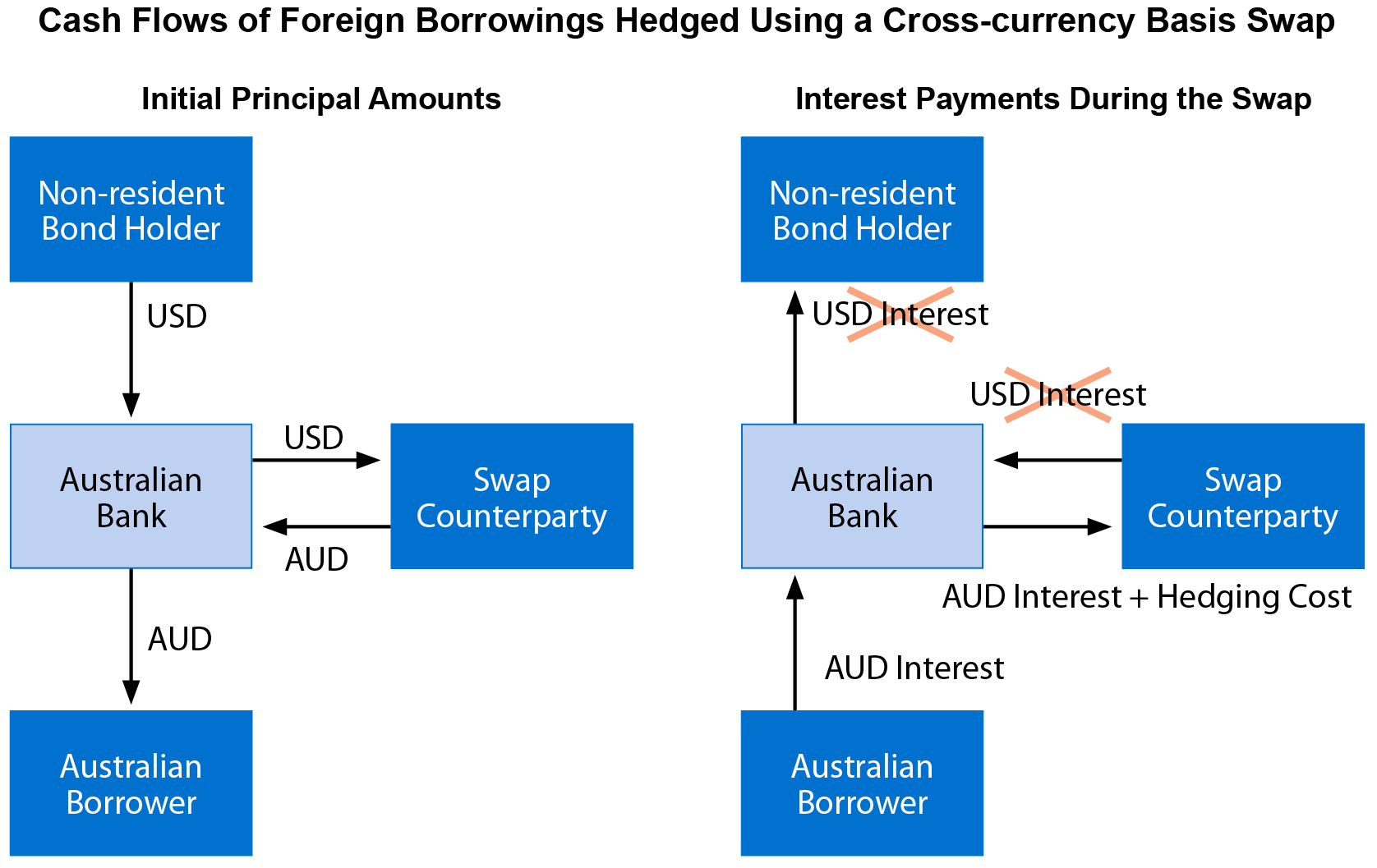
An analogy related to housing can help to further the intuition here. Imagine a Bloomberg employee who owns an apartment in New York but has accepted a temporary job in Sydney. She fully expects to return to New York and wishes to keep her property, and she does not wish to purchase a property in Sydney. The obvious solution here is for her to receive rent on her New York property and use it to pay her US dollar mortgage. Meanwhile, she can rent an apartment in Sydney using her Australian dollar income. In other words, our relocating worker can temporarily swap one asset for another. As a result, she can reduce the risks associated with servicing a US mortgage with an Australian dollar income.
As I mentioned earlier, it is common practice for Australian banks to hedge their foreign currency borrowings with derivatives to insulate themselves and their Australian borrowers from fluctuations in foreign exchange rates and interest rates. The most recent survey of hedging practices showed that around 85 per cent of banks' foreign currency liabilities were hedged (Graph 3). Also, the maturities of the derivatives used were well matched to the maturities of the underlying debt securities.[5] This means that banks were not exposed to foreign currency or foreign interest rate risk for the life of their underlying exposures. By matching maturities, banks also avoided the risk that they might not be able to obtain replacement derivatives at some point in the future (so called roll-over risk).
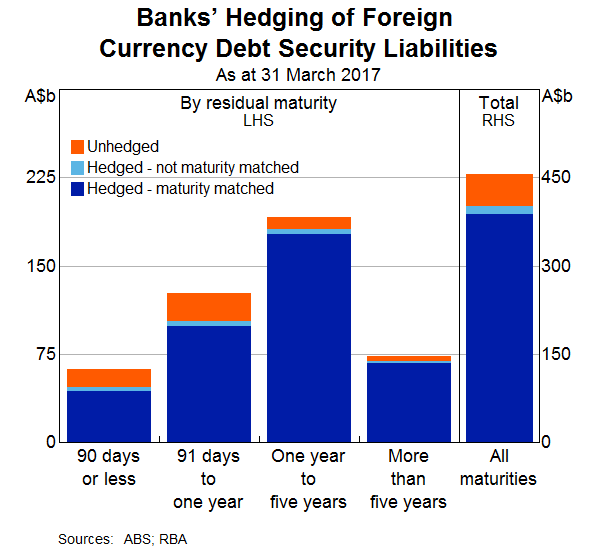
For the very small share of liabilities that are not hedged with derivatives, there is almost always an offsetting high quality liquid asset denominated in the same foreign currency of a similar maturity, such as US Treasury Securities or deposits at the US Federal Reserve. Taken together, these derivative hedges and natural hedges mean than Australian banks have only a very small net foreign currency and foreign interest rate exposure overall (Graph 4).
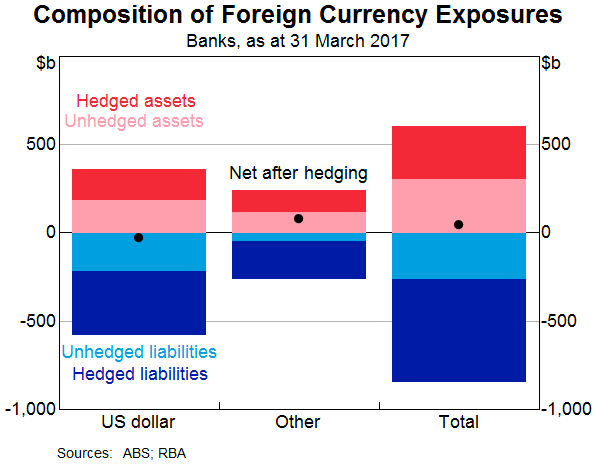
So who is bearing the risk?
Despite Australia's external net debt position, in net terms Australian residents have passed on – for a cost, as we shall see – key risks associated with their foreign currency liabilities to foreign residents. Australian residents have found enough non-residents willing to lend them Australian dollars and to receive an Australian interest rate to extinguish their foreign currency liabilities. As a result, Australians are net owners of foreign currency assets, not borrowers.[6] Collectively, Australians have used hedging markets and natural hedges to (more than) eliminate their exchange-rate exposures associated with raising funds in offshore markets.
Australians' ability to find non-residents willing to assume Australian dollar and Australian interest rate risks is a reflection of the willingness of non-residents to invest in Australian dollar assets. This in turn reflects Australia's status as a country that has long had strong and credible institutions, a high credit rating and mature and liquid capital markets. The willingness of these non-resident counterparties to assume these risks via a direct exposure to Australia's banking system – sometimes for as long as thirty years – reflects the fact that Australia's banks are well-capitalised and maintain high credit ratings. In short, Australians have found a source of finance unavailable domestically (at as reasonable a price), and non-residents have found an asset that suits their portfolio needs.
Since there are no free lunches in financial markets, there is the question of the cost for Australian banks to cover these arrangements. One part of this cost is known as the basis.
An imperfect world
Some swap counterparties have an inherent reason to enter into swap transactions with Australian banks. In other words, such exposures actually help them to manage their own risks. Non-residents that issue Australian dollar debt – in the so called Kangaroo bond market – are a case in point. These issuers raise Australian dollars to fund foreign currency assets they hold outside of Australia. This makes them natural counterparts to Australian banks wanting to hedge their foreign currency exposures. Similarly, Australian residents invest in offshore assets. To the extent that they want to hedge the associated exchange rate exposures, they too would be natural counterparties for the Australian banks.
However, it turns out that these natural counterparties do not have sufficient hedging needs to meet all of the Australian dollar demands of the Australian banks. So in order to induce a sufficient supply of Australian dollars into the foreign exchange swap market, Australian banks pay an additional premium to their swap counterparts on top of the Australian dollar interest rate. This premium, or hedging cost, is known as the basis. Simply put, the basis is the price that induces sufficient supply to clear the foreign exchange swap market.[7]
Since the start of the decade, the basis has oscillated around 20 basis points per annum (Graph 5). Typically, though not always, the longer a bank wishes to borrow Australian dollars, the higher the premium it must pay over the Australian dollar interest rate.
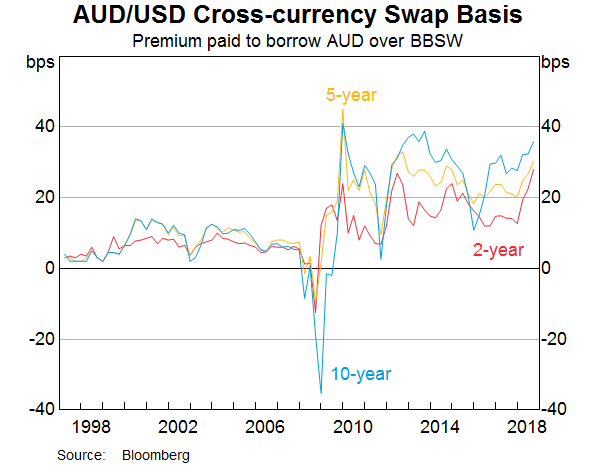
You may be wondering why Australian banks are willing to pay this premium; why don't they instead only borrow Australian dollars in the Australian capital markets to meet their financing needs? In addition to the prudent desire to have a diversified funding base as I mentioned earlier, the short answer is that it may not be cost-effective to raise all their funding at home. What tends to happen is that banks – to the extent possible – seek to equalise the marginal cost of each unit of funding from different sources. If they were to obtain all of their funding at home, that would be likely to increase the cost of those funds relative to funds sourced from offshore. So the all-in-cost of the marginal Australian dollar from domestic sources will tend to be about the same as the marginal dollar obtained from offshore.
Astute students of finance will also wonder why the basis is not arbitraged away.[8] The answer is that structural changes in financial markets have widened the scope for market prices to deviate from values that might prevail in a world of no ‘frictions’. This is consistent with the concept of ‘limits to arbitrage’ (which the academic community only started to re-engage with in the past couple of decades). Arbitrage typically requires the arbitrageur to enlarge their balance sheet and incur credit, mark-to-market and/or liquidity risk. As Claudio Borio of the BIS has noted: balance sheet space is rented, not free. And the cost of that rent has gone up.[9]
What about financial conditions more generally?
None of this is to suggest that monetary policy settings in the United States (and elsewhere for that matter) have no impact on financial conditions here in Australia. But the link is neither direct nor mechanical.
The primary channel through which foreign interest rates influence Australian conditions is through the exchange rate. An increase is policy rates elsewhere will, all else equal, tend to put downward pressure on the Australian dollar, because capital is likely to be attracted to the higher rates of return available abroad. A depreciation of the Australian dollar in turn will tend to enhance the competitiveness of our exporters, including those services priced in Australian dollars like tourism and education. Through various channels, exchange rate depreciation can also loosen financial conditions in Australia, which is not always the case in other countries, particularly those for which inflation expectations are not well anchored and where there are substantial foreign currency borrowings that are unhedged.[10]
Foreign monetary policy settings, particularly those in the United States, can also affect global risk premia. We are now approaching a period when US monetary policy is moving to a neutral stance. This follows a lengthy period of very easy monetary conditions, which may have encouraged investors to ‘search for yield’ to maintain nominal portfolio returns in an environment of low interest rates. The expectation of low and stable policy rates and inflation outcomes in turn compressed risk premia across a range of asset classes. In the period ahead, it seems plausible that term and credit risk premia will rise, which will increase costs for all borrowers, Australian banks included.
Conclusion
Global developments undoubtedly influence Australian financial conditions. In particular, developments abroad can influence the value of the Australian dollar and affect global risk premia. But changes in monetary policy settings elsewhere need not, and do not, mechanically feed through to the funding costs of Australian banks, and hence their borrowers are insulated from such changes.
Endnotes
I thank Christian Vallence for invaluable assistance in preparing these remarks. [*]
Kent, C (2018), ‘Some Features of the Australian Fixed Income Market’, Speech at the Australian Government Fixed Income Forum 2018, Tokyo, 6 June. [1]
See Debelle, G (2010), ‘Bank Funding and Capital Flows’, 23rd Australian Finance and Banking Conference, Sydney, 15 December. Also, Atkin T and B Cheung (2017), ‘How Have Australian Banks Responded to Tighter Capital and Liquidity Requirements?’, RBA Bulletin, June, pp41-50. [2]
Debelle, G (2018), ‘Lessons and Questions from the GFC’, Speech at the Australian Business Economists Annual Dinner, Sydney, 6 December. [3]
The maturity of the loans may be longer than that of the bond/swap, so a new bond/swap may be needed. [4]
Berger-Thomson, L and Chapman B (2017), ‘Foreign Currency Exposure and Hedging in Australia’, RBA Bulletin, December, pp 67-75. [5]
As a result, despite being a net debtor nation, Australia enjoys a transfer of financial wealth from abroad when the Australian dollar depreciates, other things equal. [6]
Debelle G (2017a), ‘How I Learned to Stop Worrying and Love the Basis’, Speech at the BIS Symposium: ‘CIP – RIP?’, Basel, 22 May. [7]
I direct you to any undergraduate finance textbook for a worked example that, under simplifying assumptions, demonstrates how to exploit the basis to earn a risk-free profit. [8]
Borio C et al (2016), ‘Covered Interest Parity Lost: Understanding the Cross-currency Basis’, BIS Quarterly Review, September, pp 45 – 64. Available at <https://www.bis.org/publ/qtrpdf/r_qt1609e.pdf>. [9]
Kearns & Patel (2016), ‘Does the Financial Channel of Exchange Rates Offset the Trade Channel?’, BIS Quarterly Review, December, pp95–113. Available at <https://www.bis.org/publ/qtrpdf/r_qt1612i.pdf>. [10]
